Dial M for Murder 3D Blu-ray Movie
HomeDial M for Murder 3D Blu-ray Movie 
Blu-ray 3D + Blu-rayWarner Bros. | 1954 | 105 min | Rated PG | Oct 09, 2012
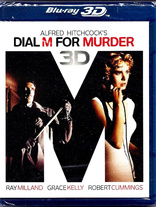
Movie rating
8 | / 10 |
Blu-ray rating
| Users | 3.5 | |
| Reviewer | 3.0 | |
| Overall | 3.1 |
Overview
Dial M for Murder 3D (1954)
Ex-tennis pro wants to have his wealthy wife murdered so he can get his hands on her inheritance.
Starring: Ray Milland, Grace Kelly, Robert Cummings, John Williams (II), Anthony DawsonDirector: Alfred Hitchcock
| Film-Noir | Uncertain |
| Psychological thriller | Uncertain |
| Mystery | Uncertain |
| Crime | Uncertain |
| Thriller | Uncertain |
Specifications
Video
Video codec: MPEG-4 MVC
Video resolution: 1080p
Aspect ratio: 1.78:1
Original aspect ratio: 1.85:1
Audio
English: DTS-HD Master Audio Mono (48kHz, 24-bit)
French: Dolby Digital Mono
German: Dolby Digital Mono
Italian: Dolby Digital Mono
Spanish: Dolby Digital Mono
Portuguese: Dolby Digital Mono
Japanese: Dolby Digital Mono
Subtitles
English SDH, French, German SDH, Italian SDH, Japanese, Portuguese, Spanish, Dutch
Discs
50GB Blu-ray Disc
Single disc (1 BD)
Blu-ray 3D
Packaging
Slipcover in original pressing
Playback
Region free
Review
Rating summary
| Movie | 3.0 | |
| Video | 2.5 | |
| Audio | 3.5 | |
| Extras | 1.0 | |
| Overall | 3.0 |
Dial M for Murder 3D Blu-ray Movie Review
Sorry, wrong number.
Reviewed by Jeffrey Kauffman October 5, 2012Dial M for Murder would have been an odd inclusion in the Alfred Hitchcock oeuvre in any case, but the fact that it was released in 3D in the waning days of the short-lived early fifties’ 3D craze makes it easily one of the oddest films Hitch ever directed. Hitch was a master of what has come to be known as “pre-viz”, whether that blueprinting took the form of storyboards or simply a head full of details. Some of the master’s preplanning has entered the halls of film legend, as in the case of the famous Psycho shower scene, which Hitch evidently had planned down to each and every shot and exactly how long they would last. But the fact is Hitchcock rarely relied on nonstop flashiness in any of his films. While many—maybe even most—of them have standout sequences, several of which were cinematically innovative and technically brilliant, those were always the “highlights” in what were otherwise fairly traditionally shot features. And so Hitch’s decision to exploit 3D seems patently strange, at the very least (even if it was foisted on him by the studio). But even dismissing the 3D as the gimmick it obviously was, Dial M for Murder is a rather strange little film in the Hitchcock canon. It was based on a successful British television play by Frederick Knott which soon matriculated to both the West End and Broadway, It was an awfully talky play, short on action and long on what must be charitably called a pretty convoluted plot, and perhaps most importantly, in its television and stage versions, it was all located in one set. Now Hitchcock was certainly comfortable working in confined places, as he proved so admirably in Lifeboat, as well as Rope, another one set piece adapted from a play which is famous for having been shot in long unedited takes. Also somewhat like Rope, we're in on the murder from pretty much the get go, and it's the unraveling afterward that provides the bulk of the suspense.
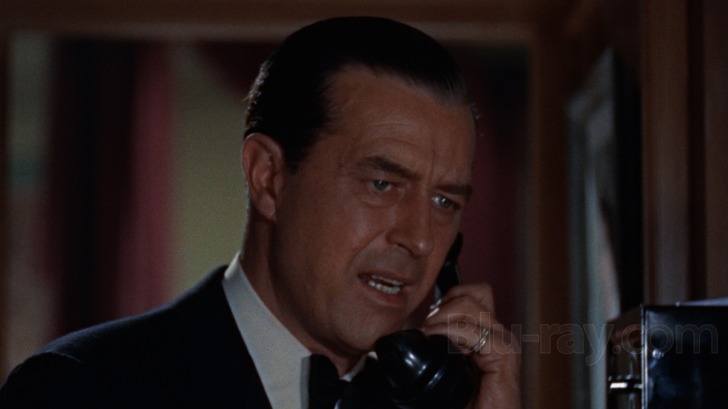
Dial M for Murder is for all intents and purposes a three person outing, and the interesting thing is that all three of the main characters are not exactly beyond reproach. Tony (Ray Milland) is a scheming former tennis pro who has married beautiful heiress Margot (Grace Kelly). Margot has not been faithful to Tony, and in fact her former lover Mark (Robert Cummings) has returned to London and wants to reignite the flame that was snuffed by Margot a year previously. In a quick clinch in Margot and Tony’s apartment, Margot reveals to Mark that she had lost a love letter from him and that she had been blackmailed for a brief time. Mark is appropriately concerned, but soon Tony shows up and they all pretend to be chummy in that way that well to do people who really can’t stand each other do. Tony insists that he has work which prevents him from going out with Margot and he insists that Mark take her instead. And that’s when the full extent of Tony’s scheming is made clear.
Tony dupes a small time crook named Swann (Anthony Dawson) over to the apartment on the pretext of buying a car he knows Swann has for sale. It turns out Swann is merely the fly caught in Tony’s web of deceit. Tony himself is the one who had gotten hold of Mark’s love letter to his wife, and he in fact had set up the blackmail scheme to see what Margot would do. When she didn’t admit her affair to him, he decided the only proper response was to kill her, and he ensnares Swann in a trap that forces the hapless man to accede and agree to kill her. Tony’s nefariousness knows no bounds, though, and he sets up an alibi which has him going out for the evening with Mark.
The set up of Dial M for Murder is actually fairly straightforward, but once we get to the ostensible murder (and it probably isn’t spoiling much to state that Margot survives) and its aftermath, things get precariously complex, especially with regard to a number of house keys that regularly change locations and putative owners. The second half of the film plays out as a sort of cat and mouse game between Tony and Mark (and to a certain extent, Margot, who ends up getting framed for the death of her attacker).
The film is an interesting study in differing performance styles. Milland and Kelly are rather well matched, both understated and typically British, faux or not. Cummings is a rather foppish lothario, however, too effete to really convince anyone he’s got the virility to sweep Margot off of her feet. Cummings never really erupted into big screen stardom, despite some good turns in films like King’s Row, with his charms being somehow more suited to television, where he did quite well in a couple of long running series. But it’s interesting to note that Hitchcock used him twice (the other outing being Saboteur), much as he utilized at least a few other actors (like John Forsythe) whose fame came largely from the small screen. Cummings is the weak link in this film, however, never quite the romantic paradigm that he needs to be.
Dial M for Murder picks up considerable steam as it rolls along, though the set up, while necessary, is awfully prolonged and rurgid at times. The film has some of the same dramatic inconsistencies that occasionally hobbled Hitch in films like The Paradine Case or Under Capricorn, with a tendency toward melodrama and not enough “classic Hitch” moments. But the final half hour or so of the film is a walloping exercise in comeuppance, wonderfully constructed (if you can keep track of all those keys) and unusually tense, even for a Hitchcock outing. The “happily ever after” that the film finally achieves does feel a little unseemly given the peccadilloes of all of these characters.
Dial M for Murder 3D Blu-ray Movie, Video Quality 
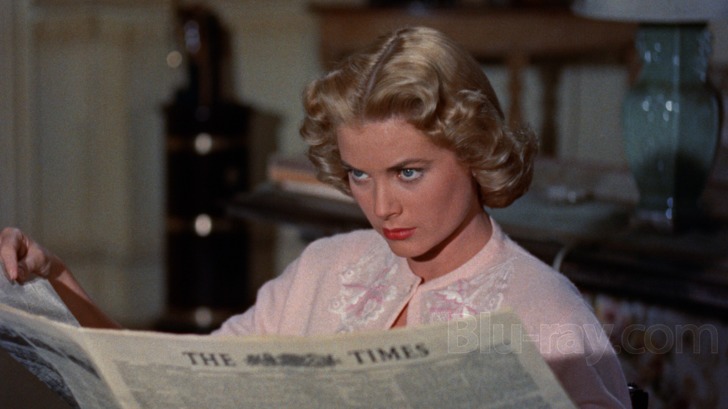
Dial M for Murder is presented on Blu-ray courtesy of Warner Brothers with AVC (2D) and MVC (3D) encoded
transfers in 1.78:1. Where to begin on this weirdly schizophrenic release? The good news: colors are gorgeously lush,
very accurate looking and extremely well saturated. Kelly's red gown in the opening segment is a vision, and flesh tones
are warm throughout the film. Close-ups are quite sharp and offer abundant fine detail. Contrast is also very strong and
helps to support the great sequence that takes place in the dark when Margot meets her attacker. There's also a natural
layer of grain abundantly evident throughout the film. The bad news: this exhibits some
of the most outrageous ringing I've ever experienced. I originally watched this
in 3D and thought perhaps this was some kind of strange 3D artifact, but it's just as present in the 2D presentation. I've
frankly never seen anything like this, and it has nothing to do with rear projection or matte work (as some are no doubt
going to want to believe). It happens in both the apartment sequences as well as some of the pretty shoddy looking rear
projection sequences. Midrange and wide shots are often little more than blobs of color, with next to no detail.
The film has attained a rather prestigious reputation for its 3D presentation, perhaps because it was never really exhibited
as a 3D picture to begin with. We're considerably more sophisticated about such things now of course, and Dial M for
Murder's dimensionality is often, well, surface deep. Hitchcock does what he can to achieve some depth, placing props
in the foreground and having his actors stand in different planes. But aside from a few standout effects—including in the
legendary "murder" sequence—this is a pretty flat presentation that also suffers from the anomalies noted above.
Dial M for Murder 3D Blu-ray Movie, Audio Quality 
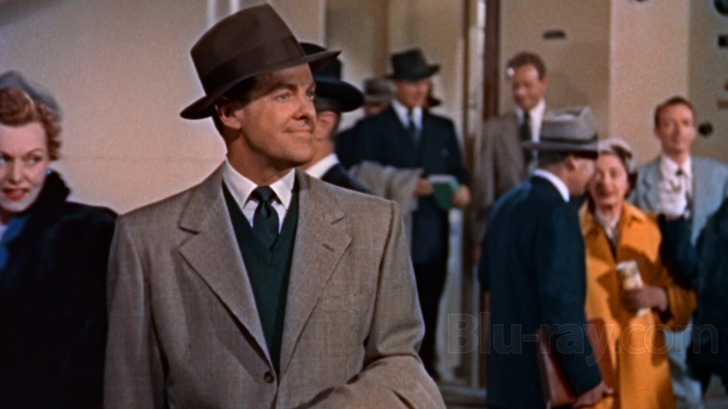
Dial M for Murder features a lossless DTS-HD Master Audio Mono mix that has weathered the ravages of time far better than the video has. Fidelity is very good throughout the film, with Dimitri Tiomkin's rather anachronistic score sounding excellent (Tiomkin seems at times to think he's scoring a sex comedy rather than a murder mystery). Dialogue is cleanly presented and the soundtrack, while pretty thin sounding at times, has not egregious damage to report.
Dial M for Murder 3D Blu-ray Movie, Special Features and Extras 
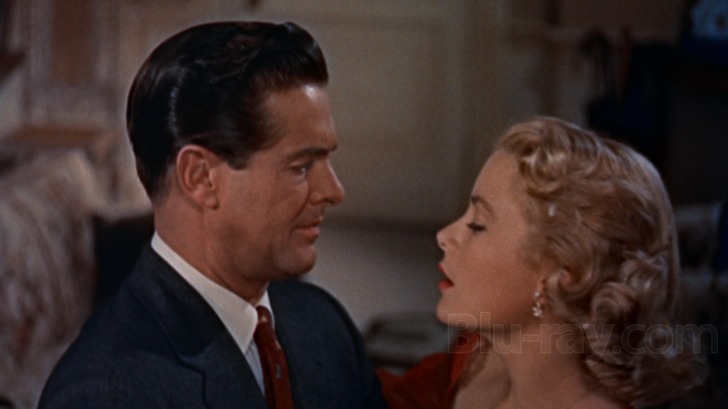
- Hitchcock and Dial M (SD; 21:37) is a good background piece that features a lot of Peter Bogdanovich (some will argue too much of him), along with Robert Osborne, M. Night Shyamalan, Richard Franklin (who did Psycho II), Pat Hitchcock O'Connell, Richard Schickel, and Nat Benchley.
- Theatrical Trailer (SD; 2:38)
Dial M for Murder 3D Blu-ray Movie, Overall Score and Recommendation 
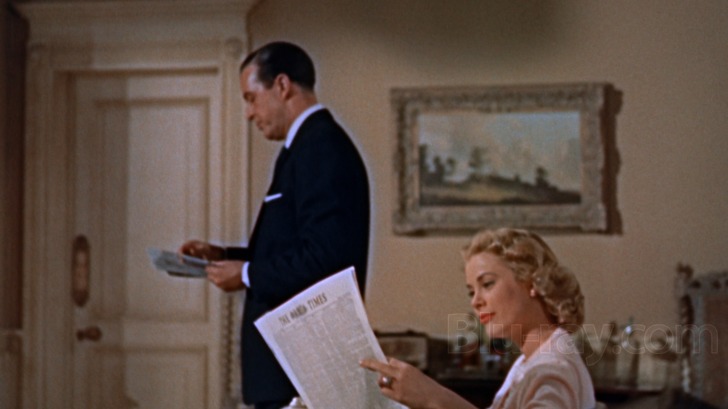
I've always been a little conflicted about Dial M for Murder, and I was hoping finally being able to see it in 3D would make me more enthusiastic about the film. Unfortunately, that simply wasn't the case. This Hitchcock piece has always struck me as too slow to develop its central conceit, and then too overly elaborate in its payoff to maintain momentum. That said, Kelly is gorgeous and Milland is extremely menacing in a smarmily smooth kind of way. Cummings I'm sorry to say just leaves me cold. The film only fitfully exploits the potential of 3D, perhaps a sign that even Hitchcock either wasn't sure what the format had to offer or perhaps was aware it was a gimmick that was breathing its last (at least for a little while). Some Hitchcock lovers absolutely adore this film, so my comments should be put in their proper perspective, namely that they're the opinion of one person, albeit someone who is a big Hitchcock fan. Even rabid aficionados of this film are apt to cringe at the bizarre haloing on display here, although the colors are luscious and some of the close-ups really pop very well. This is a caveat emptor situation where my best advice is to rent this first (if possible) if you're a fan to see if you want to include it in your permanent collection.
Similar titles
Similar titles you might also like

Strangers on a Train
1951

Vertigo 4K
1958

Malice
1993

The Big Sleep
Warner Archive Collection
1946

I Confess
Warner Archive Collection
1953

Spellbound
1945

Shadow of a Doubt 4K
1943

Laura
Fox Studio Classics
1944

Body Double 4K
40th Anniversary
1984

Heaven's Prisoners
1996

The Woman in the Window
1944

Calcutta
1946

Black Angel
Arrow Academy
1946

The Girl Hunters
Limited Edition of 2000
1963

Basic Instinct
Unrated Director's Cut
1992

The Third Man
StudioCanal Collection
1949

Lured
1947

China Moon
1994

Murder, My Sweet
Warner Archive Collection
1944

Gaslight
1944
